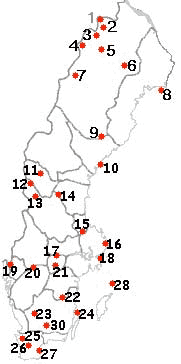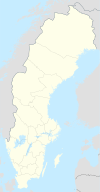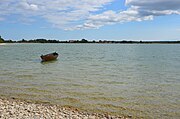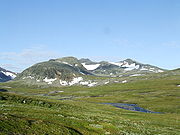National parks in Sweden
The National Park status offers the highest level of landscape protection in Sweden . With a few exceptions in the south of the country, all national parks fulfill IUCN Category II .
In 1909, Sweden was the first country in Europe to declare nine areas national parks. The aim was to preserve the untouched nature for the generation of that time as well as for all subsequent ones. Today there are 30 Swedish national parks, as well as the world's first national city park in and around Stockholm .
In 2018, around 1.56 percent of the country's area (7,023.58 km²) was designated as a national park. In addition, there are over 3500 strictly protected nature reserves that cover an area of 36,816 km². In Sweden there are a total of 19,940 nature reserves, which comprise about 15 percent of the land area and another 15 percent of the marine area.
natural reserve
Even today, the main goal of national parks (Swedish National Park ) and nature reserves (Swedish nature reserve ) is the preservation of potential natural features. Both forms are registered in the environmental law; However, the protection status is very different depending on the area and ranges from the strictest protection to weak protection similar to the German nature parks or landscape protection areas .
The national parks are to cover all six major habitats in Sweden:
Fjällgebirge
Around 90 percent of the total national park area - especially the three adjacent national parks Sarek, Padjelanta and Stora Sjöfallet in the UNESCO World Heritage Site of Laponia - is located in the Scandinavia . The treeless mountain tundra (which are called Fjäll in Scandinavia ) and the mountain birch forests of the forest tundra at the transition to the coniferous forest zone are typical of this mountain range . The largest areas belong to the low mountain regions (Lågfjäll) with extensive subarctic meadows and shrub heaths. A small part extends up to the zone of the cold desert and glaciers (Högfjäll) .
In total, around 10 percent of Sweden belong to the forest-free mountain region. Depending on the perspective of the beholder, the fell is either an almost completely untouched wilderness or an old cultural landscape of the indigenous Sami reindeer herders. A little more than a third of this region is adequately protected ( IUCN category Ia / b or II).
Coniferous forests
The boreal coniferous forest is the most widespread type of landscape in Sweden and dominates the national parks (and other large protected areas) outside the fell region. The further north, the narrower the silhouettes of the trees due to the adaptation to the harsher winters. In addition, the proportion of birch trees increases to the north and with increasing sea level.
With about 6% of the approximately 226,000 square kilometers of the total forest area Sweden has in addition to Finland for Western European conditions even over a relatively large stock of forests (according to IFL standard ) (By comparison, the 14,000 sq km forest area in Sweden is against km² 270,000 in Northwest -Russia very low. In contrast, the countries of Central Europe and the deciduous forest areas of Sweden no longer have any IFL forests). While only just under 12% of Russian areas (~ 32,000 km²) are under strict protection, in Sweden it is over 65%.
Hardwood forests
The deciduous forest - in Sweden deciduous forest called - as in Northern Central Europe mainly by beech trees , ash trees , pedunculate and sessile oak and elm formed. It is often very species-rich and offers protection and habitat for many endangered species. Today these forests only exist south of Dalälven , as in Söderåsen , Dalby Söderskog , Stenshuvud and Ängsö National Park .
Wetlands
Around a fifth of Sweden's area is covered by wetlands such as moors , swamps and wet meadows . Many plants and animals have therefore particularly adapted to these zones. Particularly beautiful and impressive wetlands can be found in the Muddus and Store Mosse National Park .
Lakes and rivers
Sweden is one of the most lake-rich countries in the world. The Djurö National Park in Vänern consists mainly of water, while the Åsnen National Park includes a large number of islands. There are still some rivers - especially in the far north - that are completely or almost completely unaffected by humans. The Vindelälven , the Torne älv , the Kalixälven and the Piteälven are therefore protected as national rivers. The Färnebofjärden National Park on the banks of the Dalälven is also a valuable freshwater area.
Coast, sea and archipelago
The national parks along the coast are very diverse. The Skuleskogen National Park, for example, has an unusually high cliff in parts ; the Stenshuvud National Park has large sandy beaches. The Haparanda Skärgård National Park is known for its sandbanks and skerries . Other unique features of some national parks are the granite rocks of Blå Jungfrun , the sand dunes of Gotska Sandön and the open sea of Kosterhavet National Park .
History and management of national parks
According to the Naturvårdsverket, the first national parks in Sweden were set up based on aesthetic or tourist criteria rather than nature conservation considerations. They were mainly in the northern parts of Sweden and many natural features such as the archipelago were not represented at all at the beginning. In the Sami- inhabited areas, the consolidation of Swedish power over the far north also played a decisive role at the beginning of the 20th century .
More recently, the procedures for establishing national parks have changed, particularly with regard to the selection and subsequent designation of new parks. In 2008, a new national park plan was adopted, which specifies clear criteria for the selection and is based on the rules of the World Conservation Union ( IUCN ).
The Swedish environmental protection agency Naturvårdsverket has the central responsibility for the protection of the area in Sweden . It also prepares government resolutions to set up new national parks. National parks and nature reserves are usually managed by the respective provincial government, but occasionally they are also administered by foundations. Free access is also guaranteed by law for all national parks.
For each national park there is an individual care plan for the sustainable preservation of the intact ecological conditions. These regulate the administrative tasks, methods and content of the ongoing monitoring of fauna and flora, measures against erosion, the signage, the network of paths and visitor guidance.
Normally, nature is left unchanged in national parks ( process protection ). Only in parks that have been set up to preserve cultural landscapes are permanent maintenance measures that correspond to historical use necessary.
Establishment and management of nature reserves
The provincial governments and the respective municipalities decide on the establishment of a protected area ( nature reserve ) after negotiations with the landowners and all other persons concerned.
Unlike a national park, a nature reserve can also be privately owned. Many nature reserves are created to protect the flora and fauna; others to serve as a kind of local recreation area with leisure and sports facilities. However, the boundaries are fluid. This is the reason for the aforementioned differences in the severity of the respective protection status.
List of national parks
| No. | Surname | surface | Province ( län ) | Swedish landscape | Landscape types | founding | location | image | |
|---|---|---|---|---|---|---|---|---|---|
| 2. | Abisko | 77 km² | Norrbotten County | Lapland | Mountain birch forest and fells | 1909 |
|

|
|
| 16. | Ängsö | 1.9 km² | Stockholm County | Uppland | Archipelago | 1909 |
|
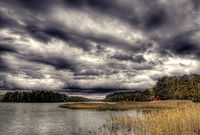
|
|
| 24. | Blå Jungfrun | 0.65 km² | Kalmar Lan | Öland | Granite island | 1926 |
|

|
|
| 9. | Björnlandet + | 11 km² | Västerbotten County | Lapland | Coniferous jungle | 1991 |
|

|
|
| 26th | Dalby Söderskog | 0.36 km² | Skåne County | Gentle | Deciduous forest | 1918 |
|

|
|
| 20th | Djurö | Västra Götalands län | 24 km² | Västergötland | Sea archipelago | 1991 |
|

|
|
| 13. | Fulufjället | 385 km² | Dalarna County | Dalarna | Mountain plateau and gorge | 2002 |
|
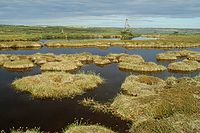
|
|
| 15th | Färnebofjärden | 101.1 km² | Dalarna County, Västmanland County, Gävleborg County | Uppland | River landscape in the mixed forest | 1998 |
|

|
|
| 17th | Garphyttan | 1.11 km² | Örebro län | Nark | Meadow cultural landscape | 1909 |
|

|
|
| 28. | Gotska Sandön + | 44.9 km² | Gotland County | Gotland | Dune island | 1909 |
|

|
|
| 14th | Hamra + | 13.83 km² | Gävleborg County | Gästrikland | Old coniferous forest and moors | 1909 |
|
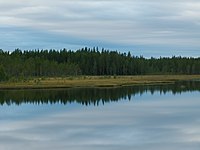
|
|
| 8th. | Haparanda Skärgård | 60 km² | Norrbotten County | Norrbotten | Sand skerries | 1995 |
|
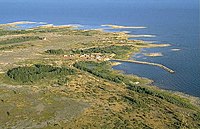
|
|
| 29 | Kosterhavet | 365 km² | Västra Götalands län | Bohuslan | Archipelago and the sea | 2009 |
|

|
|
| 22nd | Norra Kvill | 1.14 km² | Kalmar Lan | Småland | Old coniferous forest and rocks | 1927 |
|

|
|
| 6th | Muddus | 493.4 km² | Norrbotten County | Lapland | Coniferous jungle and moor | 1942 |
|

|
|
| 4th | Padjelanta + | 1984 km² | Norrbotten County | Lapland | Fells, plateaus and lakes | 1962 |
|
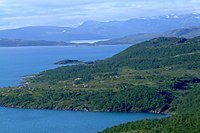
|
|
| 7th | Pieljekaise | 153.4 km² | Norrbotten County | Lapland | Mountain birch forest and fells | 1909 |
|

|
|
| 5. | Sarek + | 1970 km² | Norrbotten County | Lapland | Hochfjäll | 1909 |
|

|
|
| 10. | Skuleskogen + | 23.6 km² | Västernorrlands Lan | Ångermanland | Coniferous forest and rocky coast | 1984 |
|

|
|
| 27. | Stenshuvud | 3.9 km² | Skåne County | Gentle | Deciduous forest, cultural landscape and beach | 1986 |
|

|
|
| 3. | Stora Sjöfallet | 1278 km² | Norrbotten County | Lapland | Hochfjäll and lakes | 1909 |
|

|
|
| 23. | Store Mosse | 78.5 km² | Jönköpings län | Småland | Moorland | 1982 |
|

|
|
| 11. | Sonfjället | 103 km² | Jämtland County | Harjedalen | Isolated mountain | 1909 |
|

|
|
| 25th | Söderåsen | 16.25 km² | Skåne County | Gentle | Beech forest and gorge | 2001 |
|
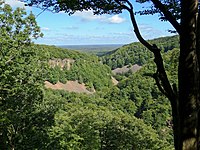
|
|
| 21st | Tiveden + | 13.5 km² | Örebro län Västra Götalands län | Västergötland | Old coniferous forest and rocks | 1983 |
|

|
|
| 19th | Tresticklan | 28.97 km² | Västra Götalands län | Dalsland | Old coniferous forest and glacial channels | 1996 |
|

|
|
| 18th | Tyresta | 20 km² | Stockholm County | Södermanland | Primeval coniferous forests | 1993 |
|

|
|
| 12. | Töfsingdalen | 16.15 km² | Dalarna County | Dalarna | Coniferous jungle and mountain heather | 1930 |
|
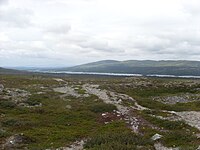
|
|
| 1. | Vadvetjåkka | 26.3 km² | Norrbotten County | Lapland | Fjäll and moor | 1920 |
|

|
|
| 30th | Åsnen | 18.68 km² | Kronobergs län | Småland | Lake and island landscape | 2018 |
|

|
Note: Planned extensions to existing national parks are marked with a + in the table above.
National park plan
In 2008 the Swedish Nature Conservation Authority presented a new national park plan after in-depth examinations and interviews with the participating provinces, organizations and landowners. In the future, 13 new national parks are to be designated and seven existing ones are to be expanded (see table). If the plan were fully implemented, the number of national parks would increase to 42. So far (2018) another planned park has been realized with the Åsnen National Park.
|
literature
- Reinhold Dey, Johannes Wendland: National parks in Sweden. Hikes in Norway, Sweden and Finland . Leopold Stocker, Graz / Stuttgart 1991, ISBN 3-7020-0615-X .
- Naturvårdsverket (ed.): Welcome to the national parks of Sweden! Leaflet . Stockholm 2009, ISBN 978-91-620-8408-0 ( naturvardsverket.se [PDF; 641 kB ]).
- Georg Terwelp: Sweden has reason to celebrate! In: National Park . No. 144 , 2009, p. 38-42 .
Remarks
- ↑ 18.73 km² for the Åsnen National Park established in 2018 were added manually
Individual evidence
- ↑ a b c d Information brochure about the Swedish national parks , swedishepa.se, PDF, accessed on September 20, 2010, German
- ↑ protectetplanet.net , accessed on January 12, 2019.
- ↑ Mark Fisher et al .: Review of Status and Conservation of Wild Land in Euope. Report on behalf of the Government of Scotland, The Wildand Research Institute, Leeds (UK) November 2010., pp. 45, 53-63, 70-72, Appendix A-3, A-4 and others. a. ( pdf ) in comparison with the mapped sources of the commons map Wilderness-and-protected-areas-of-europe, -beginning-21st-century.jpg ,
- ↑ a b Filip Hájek: Mapping of Intact Forest Landscapes in Sweden according to Global Forest Watch methodology . Prague, December 2002, accessed on January 16, 2019. pp. 7, 31–39 (conversion to forest area)
- ↑ Alexey Yu. Yaroshenko, Peter V. Potapov, Svetlana A. Turubanova: The Last Intact Forest Landscapes of Northern European Russia . Greenpeace Russia 2001. pp. 61–75 (conversion in comparison with the 2018 data in protectplanet.net, Russia ) as well as the mapped sources of the Commons map Wilderness-and-protected-areas-of-europe, -beginning-21st- century.jpg , all accessed on January 17, 2019.
- ↑ Frank Uekötter: A little history of the protection of species . In: Journal of the Federal Agency for Political Education . No. 11/2020 . bpb, March 6, 2020, p. 15 .
- ↑ Via the website | Sweden's national parks. Retrieved July 27, 2017 .
- ↑ sverigesnationalparker.se , accessed on January 15, 2019
- ↑ Naturvårdsverket: National Park Map ( page no longer available , search in web archives ) Info: The link was automatically marked as defective. Please check the link according to the instructions and then remove this notice.
- ↑ a b c Förslag till nya national park. Archived from the original on July 25, 2009 ; Retrieved September 21, 2010 (Swedish, Naturvårdsverket).
- ↑ Fördjupad förstudie nationalpark Bästeträsk . In: naturvardsverket.se, September 2018, accessed on January 16, 2019.
